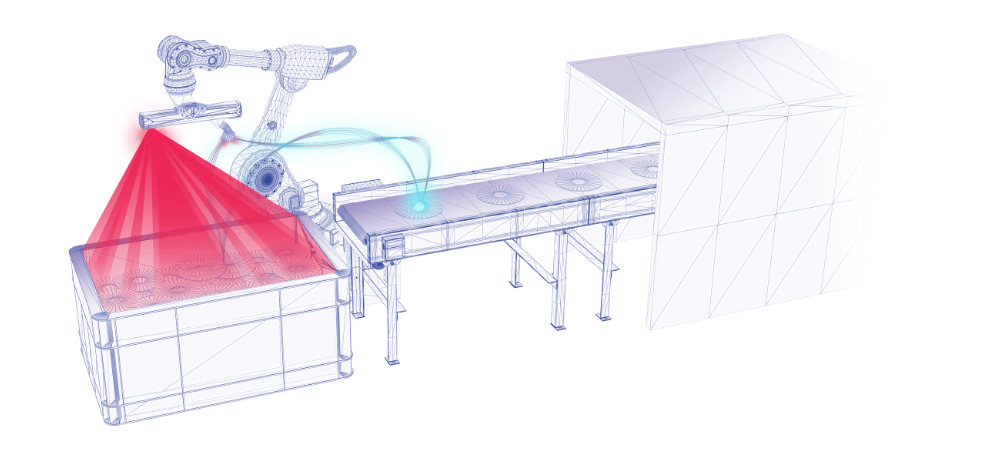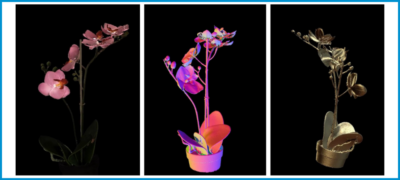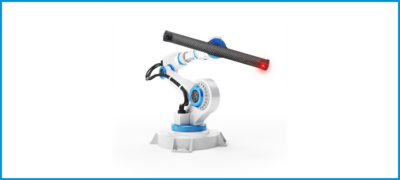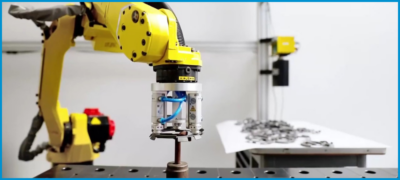
The next dimension of hand-eye applications – Motion
In robotics, a hand-eye system denotes a setup where a vision system is directly attached to the robotic arm, generally behind the very last joint. In other words, the vision system moves together with the robotic arm. This approach is rather new in robotics and offers an alternative to the more traditional fixed mounting of the vision system, usually above the working volume of the robot. Though the hand-eye approach may benefit many applications, its potential has so far been largely limited by standard vision systems. Photoneo comes with an ultimate solution that finally puts an end to these vision-based limitations.
Advantages of the hand-eye approach
The hand-eye approach is very useful in specific applications as it offers a number of advantages over the fixed-vision-system method. First of all, it can cover a much bigger scanning volume as it can be specifically directed to the area of interest, offering much more flexibility than the latter approach. The vision system is thus only limited by the reach of the robot rather than by its own scanning volume.
Because scanning distance is one of the main parameters that determine scanning accuracy, a hand-eye vision system with a shorter scanning range can provide a much higher level of detail compared to a fixed vision system with a large scanning distance. If a customer has a large bin filled with small parts, the highest level of detail will be achieved by using a small scanner with a short scanning range mounted to the robotic arm. The robot can thus approach the contents of the bin with the scanner from an optimal distance and scan the individual parts from different angles and perspectives. However, when a fixed vision system provides a satisfactory level of detail (such as Photoneo PhoXi 3D Scanner XL), it is advisable to choose the fixed-vision-system approach.
A hand-eye system is also an advantageous option in case an application comprises two or more containers. A standard setup with a fixed vision system would either require a linear axis above the bins or multiple vision systems. A hand-eye system will do with one scanner moving with the robotic arm from one container to another.
The ability to scan bin contents from a close distance and from any perspective also effectively eliminates challenges related to shadows. Bin walls or a vision system mounted above the container in a fixed manner may cast shadows on certain sections of the container, inhibiting proper scan acquisition of some parts. In such cases, a compromise needs to be made for finding the optimal position for the scanner in relation to the bin and sometimes the parts need to be manually rearranged. The hand-eye approach can easily overcome this challenge.
Finally, some applications may require special adjustments to the room where the robotic cell is placed – especially when it comes to the reduction of ambient light. The possibility to scan the container from various views minimizes the need to darken the whole room, enabling the capture of one side of the bin first and then of another.
Hand-eye systems present a modern approach with rising popularity, which gains a firm foothold in an increasing number of robotic applications. Its benefits become even more important with the rise of collaborative robotics. However, one should keep in mind that the deployment of the hand-eye approach makes real sense only in specific types of applications.
Important considerations before deploying the hand-eye approach
The choice of the hand-eye approach should always be preceded by careful consideration of the requirements and intricacies of a given application. Though this type of setup provides a number of advantages, there are certain factors that need to be considered before deciding on the hand-eye approach.
Hand-eye systems require a more difficult installation than setups with a fixed vision system. It is also more difficult to find an optimal way to handle the cables that power the deployed vision system.
In addition, because the scanner is attached to the robotic arm, it may restrict the robot’s movements. It is therefore advisable to use a smaller vision system. The most suitable models of the Photoneo PhoXi 3D Scanner family are XS, S, M and of MotionCam-3D models S, S+, and M, altogether covering a scanning range from 16 centimeters up to 1.5 meters.
Another drawback of hand-eye systems is a higher risk of colliding with the sensor and possible difficulties with finding the optimal position on the robotic arm for the vision system, especially if it is of a larger size. Another major disadvantage is the fact that robot movements cause vibrations, which standard high-accuracy area-scan vision systems cannot handle. Because of this, the robotic arm needs to stay still during scan acquisition, which may prolong the cycle time. As a result, the hand-eye approach is not the right solution for time-critical applications.
In many cases, it is better to choose the fixed-vision-system approach with a high-quality 3D vision system with a large scanning volume such as the Photoneo PhoXi 3D Scanner XL than to opt for a hand-eye system with difficult setup/installation.
Of course, there are applications where the hand-eye setup is the best option and that do greatly benefit from this approach. In those cases, the above-described drawbacks of hand-eye systems can be overcome with Photoneo’s revolutionary “Parallel Structured Light” technology – the only 3D sensing approach that can effectively resist vibrations, thus enabling high-quality 3D scanning of moving objects without motion artifacts.
Hand-eye coordination in motion
The “Parallel Structured Light” technology, implemented in the Photoneo 3D camera MotionCam-3D, enables hand-eye coordination without any trade-offs. MotionCam-3D is the only 3D vision system that provides high-quality scans even during the movement of the robotic arm. The camera is highly resistant to vibrations and does not require stopping the robot.
Because the technology enables the capture of objects moving up to 144 kilometers per hour, the vibrations caused by the movement of the robotic arm have no effect on the quality of 3D point cloud data. The camera provides a resolution of 0,9 Mpx and an accuracy of 300 – 1250 μm across the five models available (S, S+, M, M+, L). When switched to the static mode, the parameters get even higher, offering a resolution of 2 Mpx and an accuracy of 150 – 900 μm.
The greatest benefit of this is that the robot does not need to stop to make a scan, which dramatically shortens the cycle time when compared to all other technologies available on the market. It thus opens the door to new applications such as instant tracking of the object position.
This argument remains relevant also in the context of collaborative robotics, which has generally been very limited by the drawbacks of standard methods. Collaborative robots are slower per se than industrial robots and when combined with the hand-eye approach, the cycle times are prolonged even more. MotionCam-3D overcomes this limitation and works perfectly also if attached to the arm of a collaborative robot.
MotionCam-3D is available in five models – most suitable for hand-eye applications are models S, S+, and M. The smallest model S is well suited for a scanning range between 366 – 558 mm, while model S+ with the same body dimensions (80 x 68 x 307 mm) offers an extended field of view with a scanning range between 630 – 1574 mm. Model M is the right choice for a scanning distance ranging from 497 to 939 mm.
Motioncam-3D comes as an ultimate solution for any kind of robotic tasks – whether it involves static or dynamic scenes. Vision-system-based limitations of the hand-eye approach are now an issue of the past. MotionCam-3D offers the best resolution and accuracy for scanning at fast speed, effective resistance to vibrations, and shorter cycle times than ever.
If you consider deploying a hand-eye approach in your application, do not hesitate to contact us. We will be happy to consult your project with you and suggest the best solution for you.




